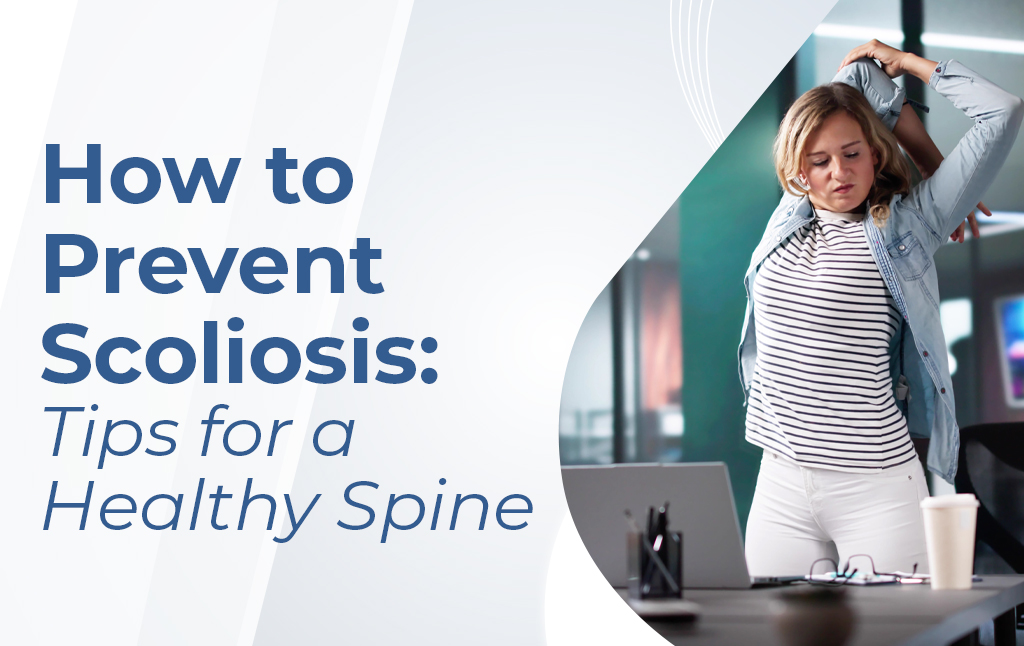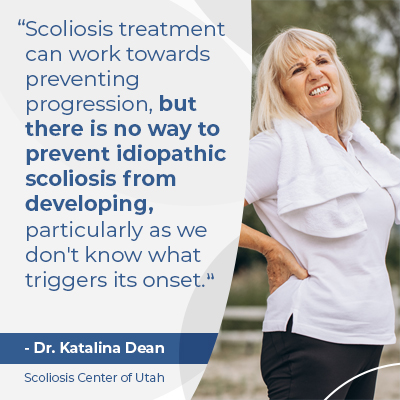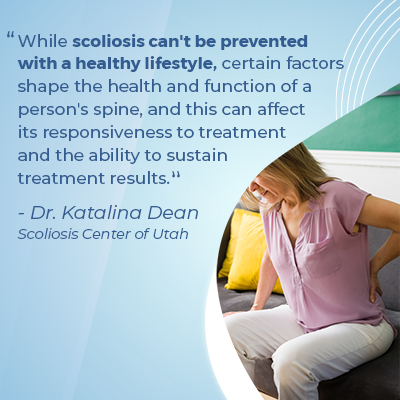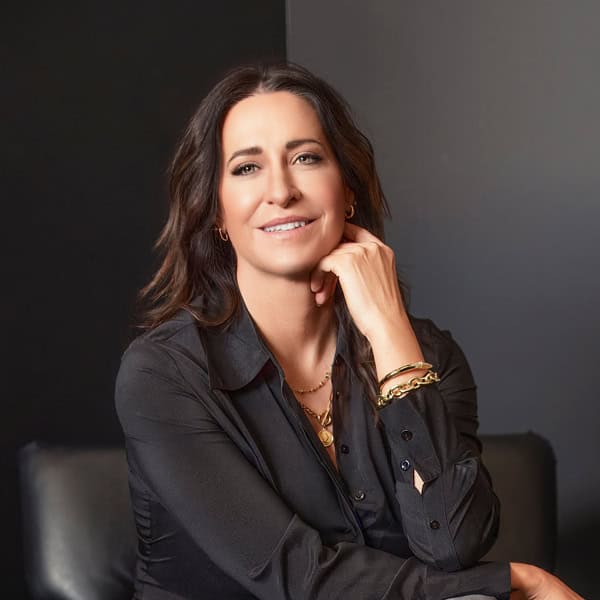Blogs
How to Prevent Scoliosis: Tips for a Healthy Spine

There is no known way to prevent scoliosis from developing. In most cases, we don’t know what causes scoliosis to develop, but we do understand the value of spinal health, how it can shape a person’s overall health, and the spine’s responsiveness to treatment.
Although scoliosis onset can’t be prevented, scoliosis progression may be preventable with a proactive and customized treatment plan. Scoliosis is progressive, but it can be highly treatable. Progression makes scoliosis more complex to treat, so an early diagnosis is key.
The best way to prevent scoliosis progression and the need for invasive surgical treatment is through early detection, intervention, and individualized treatment plans.
What Causes Scoliosis?
Scoliosis causes an unhealthy spinal curve to develop, and not only does scoliosis range widely in severity, there are also different types of scoliosis a person can develop, and type is determined by causation.
The main type of scoliosis that accounts for approximately 80 percent of known cases is idiopathic scoliosis with no single-known cause, and the remaining 20 percent are typical types of scoliosis with known causes: neuromuscular scoliosis, degenerative scoliosis, and congenital scoliosis.
Cases of neuromuscular scoliosis can be particularly severe because they are caused by an underlying neuromuscular condition such as spina bifida, cerebral palsy, or muscular dystrophy.
 Scoliosis treatment can work towards preventing progression, but there is no known way to prevent idiopathic scoliosis from developing, particularly as we don’t know what triggers its onset.
Scoliosis treatment can work towards preventing progression, but there is no known way to prevent idiopathic scoliosis from developing, particularly as we don’t know what triggers its onset.
However, we do know what triggers progression: growth.
As growth causes the size and rotation of the unnatural spinal curve to increase, it also makes it more difficult to address with treatment, so the goal is to start treatment before significant progression has already occurred.
If scoliosis is progressing, it’s becoming more severe, its effects are becoming more established and noticeable, and difficult to improve and/or reverse; this is where early detection becomes a factor capable of shaping treatment outcome.
Preventing Progression Through Early Detection
No two cases of scoliosis are the same, which is why treatment plans need to be 100-percent customized.
Scoliosis ranges from mild scoliosis to moderate and severe cases, and as a progressive condition, even scoliosis diagnosed as mild won’t necessarily stay that way; particularly in young patients who are still growing, mild scoliosis can quickly progress and become moderate or severe.
Scoliosis can be treated with surgery or nonsurgical treatment, and one of the largest benefits of a nonsurgical treatment approach is that it values early detection and a proactive response.
Early detection means diagnosing scoliosis while it’s still mild, before significant progression has occurred and condition effects have become well established.
Early Detection and Early Intervention
The benefit of early detection is that it means early intervention is within reach, but only to patients who have committed to a proactive nonsurgical treatment approach.
Nonsurgical treatment is what patients of the Scoliosis Center of Utah benefit from, and the goal is preventing progression through working towards improving the spine’s position, balance, body posture and alignment.
Early detection is only possible with awareness: knowing the types of changes scoliosis can cause in its early days, and being able to recognize these indicators, can lead to an early diagnosis, and more importantly, early intervention.
Scoliosis Symptoms
The earliest signs of scoliosis in children are postural changes including uneven shoulders, uneven shoulder blades, an arch in the rib cage, uneven hips, and arm and leg length discrepancies.
The more a patient’s posture is disrupted, the more movement is also affected as the uneven forces of the condition are increasing.
Disruptions to balance, coordination, and gait are common, and the development of unhealthy movement patterns can impact the entire body.
The sooner the signs of scoliosis are recognized, the sooner an assessment can be performed, the sooner a diagnosis can be reached, and treatment can be started.
Starting treatment while scoliosis is mild means the curve is small and flexible and is likely to respond well to nonsurgical treatment, and as a significant amount of progression hasn’t yet occurred, postural changes aren’t overt so are simpler to improve and/or reverse.
The signs of mild scoliosis are often missed, which is why most patients are diagnosed with moderate scoliosis, after the early subtle signs have become more overt due to progression.
While there are no treatment guarantees, when treatment is started while scoliosis is mild, preventing progression into the moderate and severe levels may be within reach.
Everyone can benefit from leading a spine-friendly lifestyle, and for people with scoliosis, leading a spine- and scoliosis-friendly lifestyle are key.
Spine-Friendly Lifestyle Tips
 While scoliosis can’t be prevented with a healthy lifestyle, certain factors shape the health and function of a person’s spine, and this can affect its responsiveness to scoliosis treatment and the ability to sustain treatment results.
While scoliosis can’t be prevented with a healthy lifestyle, certain factors shape the health and function of a person’s spine, and this can affect its responsiveness to scoliosis treatment and the ability to sustain treatment results.
Spinal health benefits from maintaining a healthy weight, activity level, posture, and strong core and back muscles.
Carrying excess weight strains the body’s frame, muscles, and joints, and can strain the spine’s individual structures like the spinal discs. Carrying excess weight also tends to lead to unhealthy movement patterns and poor posture.
The spine’s natural design is movement-based, so it needs consistent activity to stay strong and flexible, and as the spinal discs don’t have their own vascular supply, they need movement to increase circulation and make nutrients needed for repair more readily available.
Low activity levels can also lead to a loss in muscle strength and endurance, and the spine needs to be surrounded by strong and supportive muscles to maintain its natural curves and alignment.
The aforementioned factors – weight, activity, and muscle strength – all promote good posture, and the way the body is held during daily activity shapes the spine’s position, so posture and spinal health are closely associated.
Proactive Nonsurgical Scoliosis Treatment
When it comes to improving spinal health and preventing scoliosis from getting worse, there are never treatment guarantees, but this can be worked towards through a proactive treatment response.
To diagnose scoliosis, a patient’s detailed medical history, with a focus on any family history of scoliosis, is explored, along with a postural and movement assessment, and X-ray results.
If the spine has developed an unnatural sideways curvature that also rotates, its balance and stability has been disrupted, and if left untreated, the nature of the curve is to increase in size over time, and with growth, and its effects are likely to increase, along with the risk of complications.
Here at the Scoliosis Center of Utah, the approach is nonsurgical and integrative and combines the power of scoliosis-specific chiropractic biophysics, physical therapy, and corrective bracing.
Chiropractic adjustments and techniques can work towards improving the spine’s balance, alignment, and stability by targeting the position of the curve’s most-tilted vertebrae.
A comprehensive exercise-based program, ScoliBalance® combines the potential of chiropractic care and physical therapy by teaching patients postural awareness and a variety of scoliosis-specific exercises that can help counteract the curve, manage progression, pain, improve spinal flexibility, body posture, back and core muscle balance and strength, and spinal alignment.
When corrective bracing is integrated into a treatment plan, the scope of nonsurgical treatment is widened, and as corrective bracing is more effective on growing spines, it is a regular facet of childhood scoliosis treatment.
The corrective and modern ScoliBrace® helps by placing the spine in a straighter alignment, and because the modern brace is designed with movement in mind, it complements the ScoliBalance® program as the different treatment disciplines work together to impact scoliosis on every level.
Conclusion
While there is no way to prevent idiopathic scoliosis from developing, there are healthy lifestyle practices that can shape a person’s spinal health and function.
From maintaining a healthy weight to incorporating daily exercise, increasing core strength, and practicing good posture, spinal health is key to overall health.
For those diagnosed with scoliosis, practicing a spine-friendly lifestyle means cultivating scoliosis-friendly practices that are conducive to healing, making the spine more flexible, responsive, and most importantly, treating the scoliosis proactively.
Here at the Center, scoliosis treatment plans are comprehensive and customized. Treatment is started immediately following a diagnosis because as a progressive condition, this is when scoliosis will be at its mildest and most responsive.
Healthcare professionals who specialize in scoliosis treatment understand the value of timing; with progressive conditions, when treatment is started can be an important factor, so the sooner treatment is started, the better.
Customizing a nonsurgical treatment plan around key patient/condition variables is the best way to prevent scoliosis from progressing and causing increasing effects.

Dr. Katalina Dean
Dr. Katalina Dean is the founder and clinical director of Scoliosis Center of Utah, in Midvale, UT. Her team specializes in posture correction, spinal rehabilitation, and non-invasive scoliosis care and bracing.
Call Today
Do You Qualify for Care?
Schedule an Appointment Below
